What are Performance Max Campaigns?
Performance Max is Google’s next generation of smart, goal-based ad campaign that allows performance-driven marketers to advertise and access all Google Ads Inventory from a single campaign deck. This means that Performance Max campaigns will allow you to advertise on Google Search, Shopping, YouTube, Gmail, Display, Discover, and Maps, maximising your advertising efforts in a fully co-ordinated process.
At first glance, it maybe sounds more of the same. But this new set up is absolutely amazing, especially if you’re new to Google Ads, as it could mean less time, effort and anxiety is involved in setup and management of your campaigns. Of course,, if you are a more experienced advertiser, Performance Max could mean nothing more than an added challenge, given that it takes away so much of your control because of its black box nature and limited placement and targeting options.
For those of us who have moved with the evolving algo’s and even anticipated changes happening with Google advertising, the launch of Performance Max came as a surprise back in November 2021, when Google announced its roll out.
Many Ecommerce advertisers were still getting used to Smart Shopping campaigns, as these were only introduced back in 2018. It’s often been a dilemma for many marketers, whether to run Standard Shopping Ads or Smart Shopping Ads for promoting their products on Google Shopping. Weighing up the relative benefits of control, versus leveraging Google’s mass of meta-data can be a tough call.
However, Google has confirmed that Performance Max campaigns will replace Smart Shopping and Local Campaigns. It seems the transition phase will start from April 2022, when Google will allow you to upgrade, using a one-click tool, then will gradually move onto upgrading all the Smart Shopping Campaigns in August 2022. Google plans to finish all upgrades by September 2022.
It’s worth mentioning that Google has confirmed that Standard Shopping campaigns will remain available, for those who want to remain in charge of the mechanics of their Shopping Campaigns, so those marketers who like control of the gears and levers will not be side-lined. However, we have to wonder if Google is running their own split test here, to show how the magic of A.I. can beat the best manually operating marketers in future. I guess we will know by next year…
For the past few years, we have all observed how all advertising platforms including Google are headed towards full automation, using smart campaigns powered by A.I and machine learning. So, for what is worth, maybe it’s time to not resist the changes so much and make the most of the march of the bots, by evolving our marketing strategies towards integrated human and machine driven decision-making.
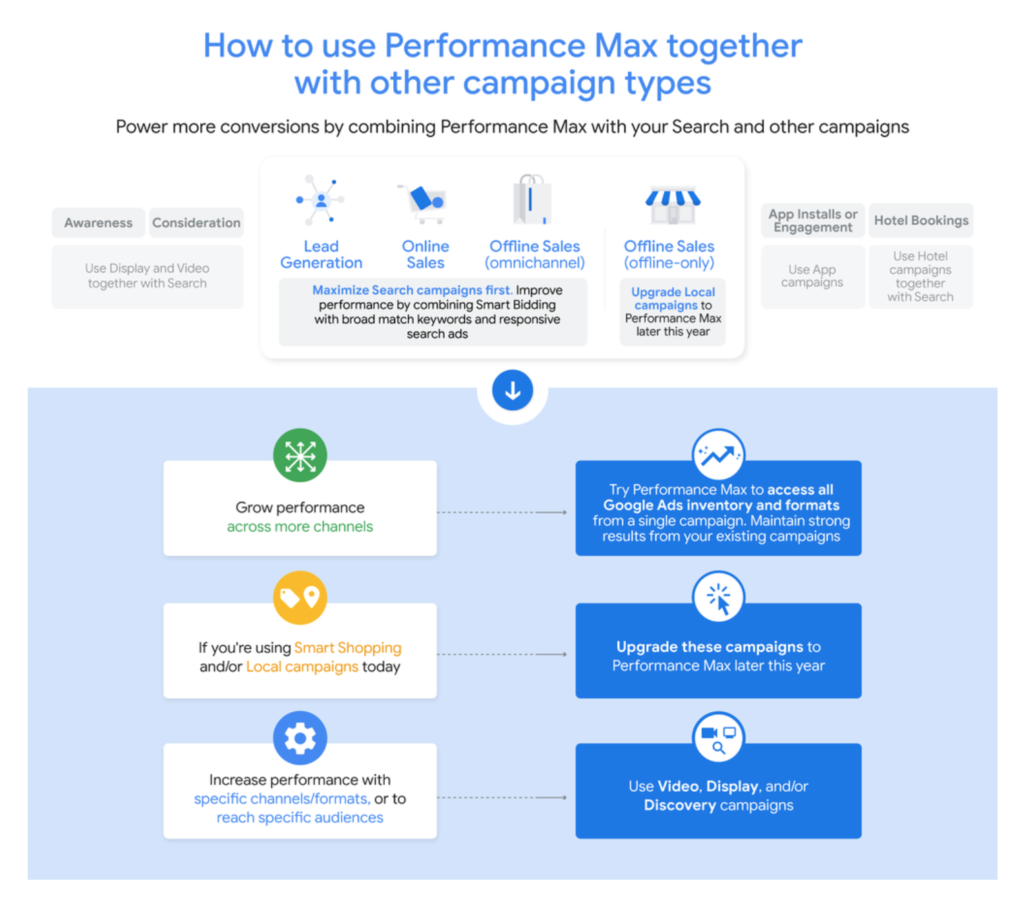
Image Source: Google
How Do Performance Max Campaigns Work?
Performance Max campaigns take a ‘full-funnel marketing’ approach, by prospecting new audiences, as well as simultaneously remarketing to your existing audience segments across all Google’s platforms. Machine-learning will mean on-going optimising of performance, in real-time; this is possible from combining Google’s automation technologies across: bidding, budget optimisation, audiences, creatives, attribution, etc. All the while, Google’s evolving algorithmic instructions will be enhancing the mind-bending array of ad variables and shifting the weight of their significance so the viewer converts more quickly and readily as a customer. Thus, businesses benefit from Google’s artificial intelligence advancements by generating leads, sales or local store visits.
Think of Performance Max as running a combination of search, shopping, display and YouTube Ads all in one place, with the aid of a marketing brain the size of a planet. In simple terms, you decide on your campaign goal, aligned with your business objectives, e.g. Sales or Lead Generation. You then share with Google your creatives, define who your target audience could be as closely as possible, decide on your bidding strategy, according to available budget and based on your desired targets, then crack on with other priorities, checking in every now and then to watch Google do its job.
Sounds simple, huh? Unfortunately, automation doesn’t always work that way. The truth is that machine learning is not yet perfect, we humans are not always rational decision makers, and more importantly our motivations can differ quite a lot from Google’s (boosting it’s revenue and making more money from selling ads). So let’s explore our options here, by going through the entire, new setup.
How to Create a Performance Max Campaign
- Choose Your Campaign Objective
You can create a new campaign by clicking on the ‘+’ sign on your Google Ads management page. Once you create a new campaign, you’re prompted to select your campaign objective.
Bear in mind that Performance Max campaigns are only available with: Sales, Leads, Website Traffic, Local store visits and Promotions as objectives.
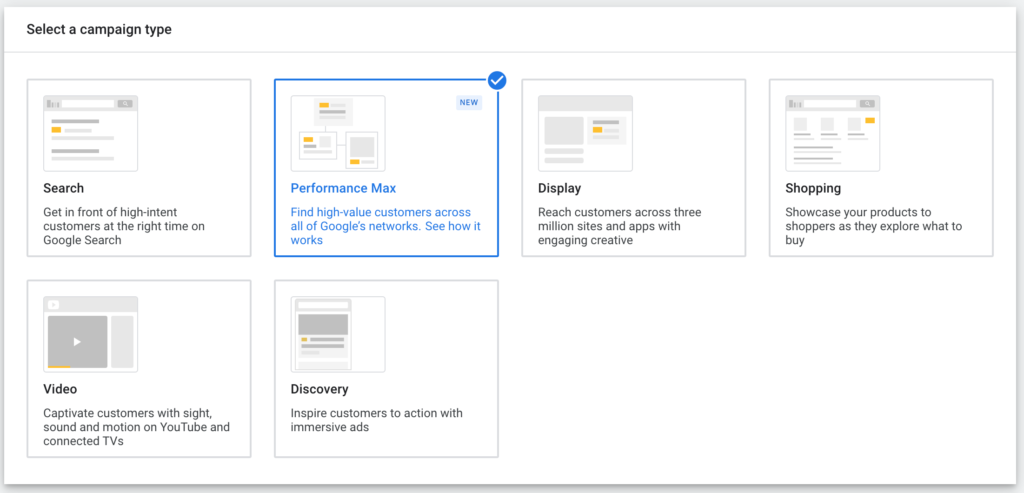
2. Select Your Preferred Campaign Type
Here, you should select “Performance Max” campaign.
3. Select Your Conversion Goal
Next, you’re prompted to select a conversion goal, which helps Google optimise your ads for, e.g. Purchases, Leads, etc.
It’s important to remove unnecessary conversions, e.g newsletter subscriptions, app downloads, or other defined outcomes that are not a priority for this campaign. If you have multiple conversion goals, then it’s best to define which one is your primary, which one is your secondary conversion goal and so on.
4. Budget & Bidding Strategy
You then need to decide your daily budget. Google recommends starting with an average daily budget of at least three times your CPA or cost/conversion.
Once set, you should then select from your available bidding strategies. Maximise Conversions comes with an option CPA target. Maximise Conversion Value comes with the option of target ROAS. These inputs help Google understand your targets.
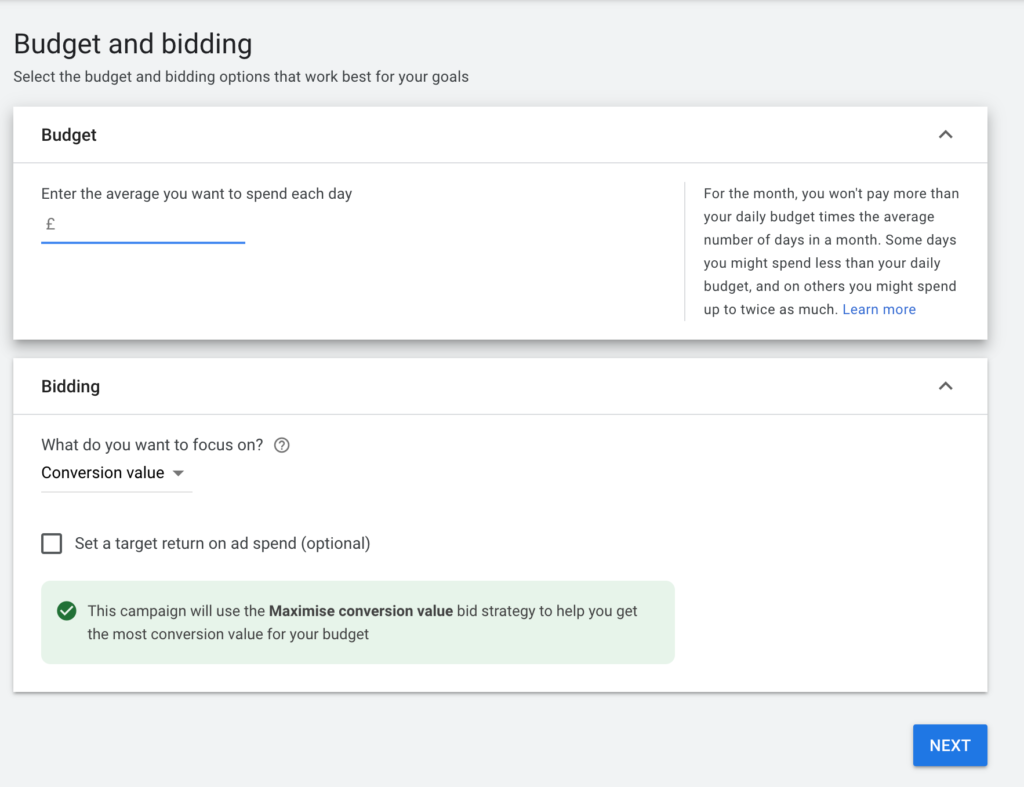
5. Campaign Settings
Next, you need to sort out your campaign settings which underpin your Google advertising Campaign. Here are the options you need to decide upon:
- Locations & Languages
You need to select the location(s) and language(s) you are targeting. Google will only
allow you advertise those products which are approved for the countries you wish to market to; this can be checked in your Google Merchant Center. Language selection is essentially needed for your search ad campaigns.
- Final URL Expansion
Final URL expansion with Performance Max gives you two options:
- Send traffic to the most relevant URLs on your site that match your business objectives.
This feature works similar to Dynamic Searches, whereby you can allow Google to pull data from URLs on your website to automatically generate a headline for each ad to match the searcher’s intent in real time.
If you do opt in for this machine-learning decision making, we strongly recommend going through your URLs to make sure you exclude irrelevant ones from showing up.
2. Only send traffic to the URLs that you’ve provided.
Alternatively, you can tell Google to not search beyond your stated URLs and only drive traffic to your listed product page, landing pages and final URLs in your asset groups.
- Campaign URL Options
You can use these options for sending data to 3rd party tracking platforms, or by pushing specific UTM parameters as a part of your URL, by defining them as a template.
- Ad Schedule
Unlike its predecessor, Smart Shopping, Performance Max allows you to set Ad Scheduling, telling Google on which days and hours of the week you wish to display your ads. It’s an interesting campaign management process, as you’d expect Google to automatically optimise for conversions during the best hours and days of the week.
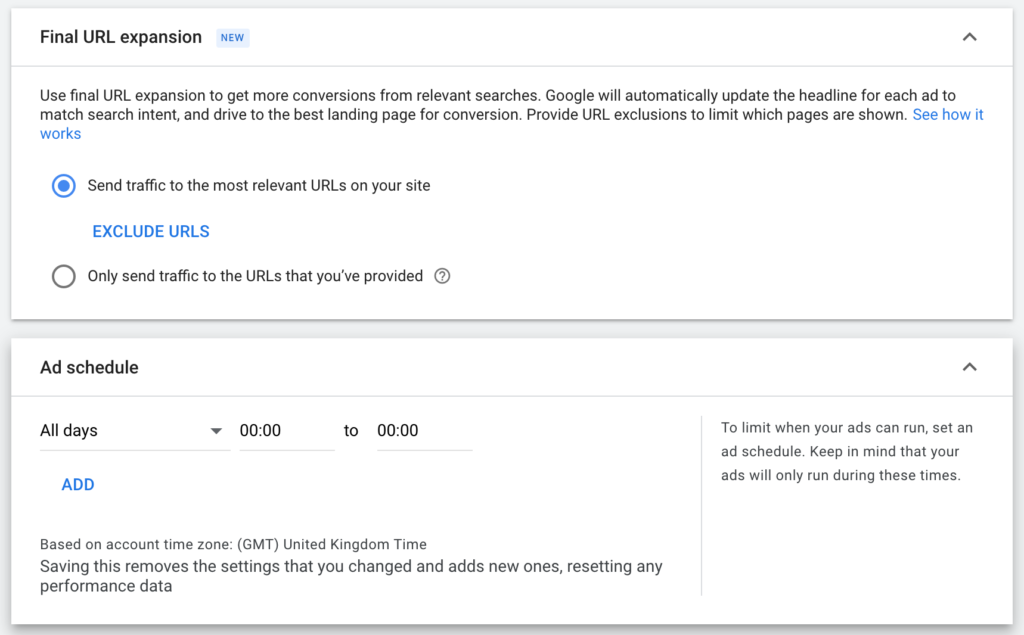
6. Asset Groups
You can think of asset groups as a new version of your ad groups. Here, you choose to select your product groups, ads and audiences all in one place. In fact, you can create up to 100 asset groups. Here are the three key parts of asset groups:
Listing Group
After you give your asset group a name, it’s time to choose which products will show in your ads. By default, “All Products” is pre-selected for you. However, we strongly recommend you think about this carefully and choose those products matching your campaign’s objective and your desired returns. For example, if you have thousands of products, you might want to only target your best sellers for a higher ROAS, then create other Asset Groups, or even campaigns for other products.
Assets
Assets are all your creatives in one place. You can select up to 15 images, 5 logos, 5 YouTube videos, 5 Headlines, 5 Long headlines, 5 Descriptions, together with your business name and final URL.
Google will then use your provided creatives to dynamically generate a series of Ads, which it will place and advertise across its platforms.
If you don’t have videos, Google will use your assets to create dynamic videos using your images and creatives. Unfortunately, they’re not the most attractive and engaging, once you see them, so, it’s worth putting the effort and budget into creating your own video to keep your brand messaging consistent and professional.
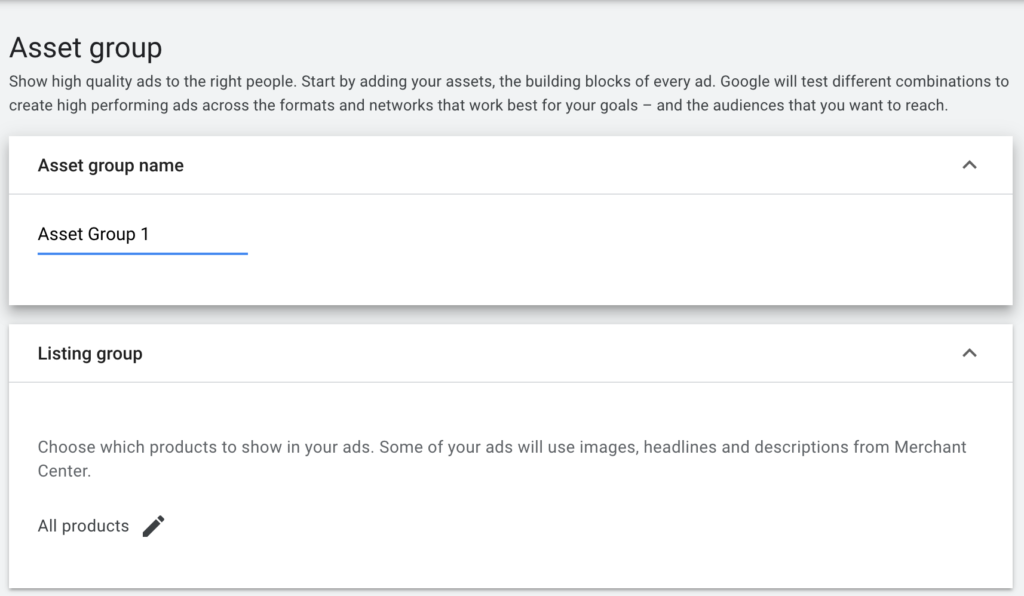
Audience Signal
If you’re familiar with Audience Targeting you will know that Audience signal is the closest you get to this in Performance Max campaigns. Instead of telling Google who to target exactly, you can create and add audiences by directing Google in the right direction. As the name implies, you’re signalling to Google’s algorithms where could be a good starting point for finding suitable customers for you.
An audience signal is created using a combination of:
- Custom Segments – Based on their search activity, downloaded apps or visited websites.
- Your Data Segments – People who have previously engaged with your business, visited your website, or added a product to their cart
- Interest & Detailed Demographics – Based on in-market segments, Affinity Segments, life events, detailed demographics, such as education and employment
- Demographics – Gender, Age, Parental Status, Household Income, etc.
7. Extensions
You can then finish off creating your campaign with your ad extensions. There are several extensions you can add to your campaign, such as sitelink extensions, callout extensions, call extensions, lead form extensions, promotion extensions and a few more.
We strongly recommend adding all the relevant and applicable ad extensions to your campaign, as it would help your search ads perform much better.
Finally, go through the Summary to fix any input errors, you’re finally good to go! Your campaign is ready to go live and the toughest part of your learning about Performance Max Campaigns is under your belt. Give yourself a pat on the back, grab a coffee and get set to watch the fireworks!
How to Optimise Performance Max Campaigns?
Similar to all your other campaigns, having a clear structure is the key to better A.I optimisation and easier management. Here are our key recommendations for optimising your Performance Max campaigns;
Campaign Priority
Except for a few exceptions, Performance Max campaigns have a higher priority over pretty much all of your campaigns in Ad Auctions.This means that if you have multiple campaigns running, such as: Search Campaigns, Standard Shopping, Smart Shopping, Display Campaigns and etc, then Performance Max campaigns gets the highest priority in most cases. Hence, you’ll experience the impact across your other campaigns. One considerable exception is Search Campaigns using Exact Match, but we’ll get to that.
Campaign Structures
You can have multiple Performance Max campaigns running at the same time. However, it’s important to not have the same products in different campaigns fighting against each other. If you are selling a large variety of products in different categories, it’s best to divide them into categories, e.g., by product type and have them assigned to separate campaigns. This also helps you follow a different bidding strategy for each campaign.
Number of Asset Groups
Google allows you to create up to 100 asset groups per campaign. That being said, although it’s a good idea to have two or three asset groups per campaign to compare relative performance against each other, it’s not really a good idea to overdo it and have tens of asset groups, as you might make it harder for the A.I. to optimise efficiently. Even Google’s smart algo’s have their limits!
Product Feed Optimisation
If you’re running an E-commerce store, just like with your other Google shopping campaigns, having a well optimised product feed will really come in handy here, as you can categorise your products much faster and easier. Well-optimised product images, titles and descriptions will lead to higher sales performance of your products across shopping ads.
Assets Quality
After a few days of running your Performance Max campaigns and once they have generated enough impressions, Google will rank your Assets. These are your previously inputted creatives, now tested in real campaigns from which you will gain an overview of their performance. The rankings are based on the 3 values of: Low, Good and Best.
You should use this indicator to continually improve on the quality of your creatives, then maintain as many “Best” ranked assets in your campaign to push your campaign’s performance.
Safeguard Your Branded Terms
If you have search campaign ads running against your branded keywords, such as your brand name and product names, which are usually your money makers, it’s worth setting your keywords as ‘exact match’, to give them a higher priority against your pMax campaigns so that your campaigns won’t be impacted by running them in parallel with Performance Max ones.
Negative Keywords
Unfortunately, similar to Smart Chopping campaigns, Performance Max campaigns don’t allow for applying your negative keywords list and preventing certain keywords from being triggered. However, Google has confirmed that “Account-level negative keywords will soon be available and can be used to exclude certain search terms from your Performance Max campaigns.” You may also use the brand safety settings to add certain exclusions, such as content, placement and inventory type exclusions. You can select these in your account settings.
Important Advice
As mentioned earlier, pMax campaigns don’t offer any control on where your ads appear across Google’s platforms and surfaces. Hence, for some businesses who have contracts that prevent them from advertising or displaying their ads on certain platforms, this can be a problem. For instance, some business contracts may not allow you to advertise your services on Google maps, due to competition, or your supplier may not allow you to bid on their branded terms.
Hence, it’s worth looking into this side of your business constraints to see if any aspect of running a performance campaign may put you in danger of breaching your existing contracts, or worse still, incurring liabilities.
Final Thoughts About pMax Campaigns
We know there is a lot to take in with Google’s latest roll-out for advertisers, but hope you’ve found this article useful. Like all new ad campaigns, we think it would help you to start experimenting with Performance Max campaigns sooner rather than later, not least because change is here, so you may as well get in it to win it; doubtless some of the bigger players will be already. Here at AdsRunner regardless of the size of your business, or sector, we provide full Google Ads Management and support for your teams, covering all types of online campaigns.
If you need more information, or help with your current setups, reach out to us, we’ve probably seen your dilemmas before and will offer straight advice, or quote you for what you need, following a full consultation, at no obligation to you …. Otherwise, why not check out more on our Google Ads Services, while you are chewing things over?
- Written by: Sam Nouri
- Posted on: April 4, 2022
- Tags: Google Ads
